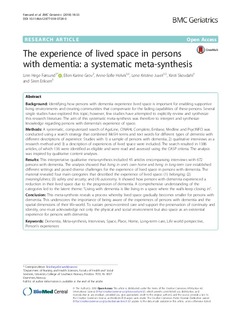| dc.contributor.author | Førsund, Linn Hege | |
| dc.contributor.author | Grov, Ellen Karine | |
| dc.contributor.author | Helvik, Anne-Sofie | |
| dc.contributor.author | Juvet, Lene Kristine | |
| dc.contributor.author | Skovdahl, Kirsti | |
| dc.contributor.author | Eriksen, Siren | |
| dc.date.accessioned | 2018-08-08T12:21:32Z | |
| dc.date.available | 2018-08-08T12:21:32Z | |
| dc.date.created | 2018-02-12T10:58:24Z | |
| dc.date.issued | 2018 | |
| dc.identifier.citation | BMC Geriatrics. 2018, 18:33, 1-27. | nb_NO |
| dc.identifier.issn | 1471-2318 | |
| dc.identifier.uri | http://hdl.handle.net/11250/2508056 | |
| dc.description.abstract | Background:
Identifying how persons with dementia experience lived space is important for enabling supportive living environments and creating communities that compensate for the fading capabilities of these persons. Several single studies have explored this topic; however, few studies have attempted to explicitly review and synthesize this research literature. The aim of this systematic meta-synthesis was therefore to interpret and synthesize knowledge regarding persons with dementia’s experience of space.
Methods:
A systematic, computerized search of AgeLine, CINAHL Complete, Embase, Medline and PsycINFO was conducted using a search strategy that combined MeSH terms and text words for different types of dementia with different descriptions of experience. Studies with 1) a sample of persons with dementia, 2) qualitative interviews as a research method and 3) a description of experiences of lived space were included. The search resulted in 1386 articles, of which 136 were identified as eligible and were read and assessed using the CASP criteria. The analysis was inspired by qualitative content analyses.
Results:
This interpretative qualitative meta-synthesis included 45 articles encompassing interviews with 672 persons with dementia. The analysis showed that living in one’s own home and living in long-term care established different settings and posed diverse challenges for the experience of lived space in persons with dementia. The material revealed four main categories that described the experience of lived space: (1) belonging; (2) meaningfulness; (3) safety and security; and (4) autonomy. It showed how persons with dementia experienced a reduction in their lived space due to the progression of dementia. A comprehensive understanding of the categories led to the latent theme: “Living with dementia is like living in a space where the walls keep closing in”.
Conclusion: This meta-synthesis reveals a process whereby lived space gradually becomes smaller for persons with dementia. This underscores the importance of being aware of the experiences of persons with dementia and the spatial dimensions of their life-world. To sustain person-centred care and support the preservation of continuity and identity, one must acknowledge not only the physical and social environment but also space as an existential experience for persons with dementia. | nb_NO |
| dc.language.iso | eng | nb_NO |
| dc.rights | Navngivelse 4.0 Internasjonal | * |
| dc.rights.uri | http://creativecommons.org/licenses/by/4.0/deed.no | * |
| dc.title | The experience of lived space in persons with dementia: a systematic meta-synthesis | nb_NO |
| dc.title.alternative | The experience of lived space in persons with dementia: a systematic meta-synthesis | nb_NO |
| dc.type | Journal article | nb_NO |
| dc.type | Peer reviewed | nb_NO |
| dc.description.version | publishedVersion | nb_NO |
| dc.rights.holder | © The Author(s). 2018 | nb_NO |
| dc.source.pagenumber | 1-27 | nb_NO |
| dc.source.volume | 18:33 | nb_NO |
| dc.source.journal | BMC Geriatrics | nb_NO |
| dc.identifier.doi | 10.1186/s12877-018-0728-0 | |
| dc.identifier.cristin | 1564271 | |
| cristin.unitcode | 222,56,1,0 | |
| cristin.unitname | Institutt for sykepleie- og helsevitenskap | |
| cristin.ispublished | true | |
| cristin.fulltext | original | |
| cristin.qualitycode | 1 | |

